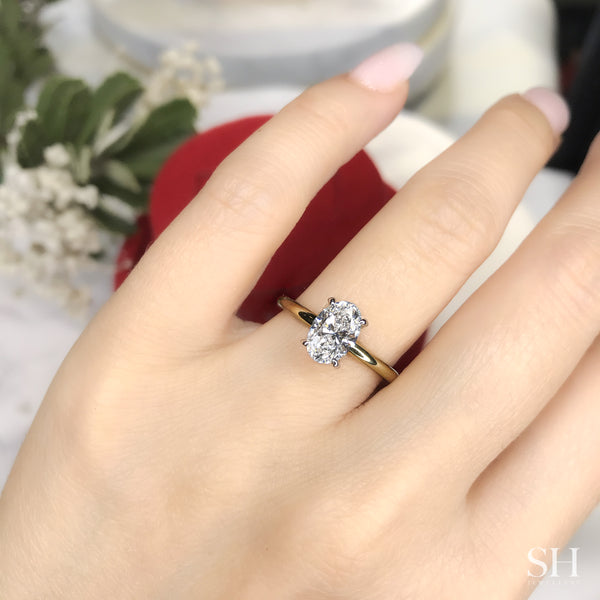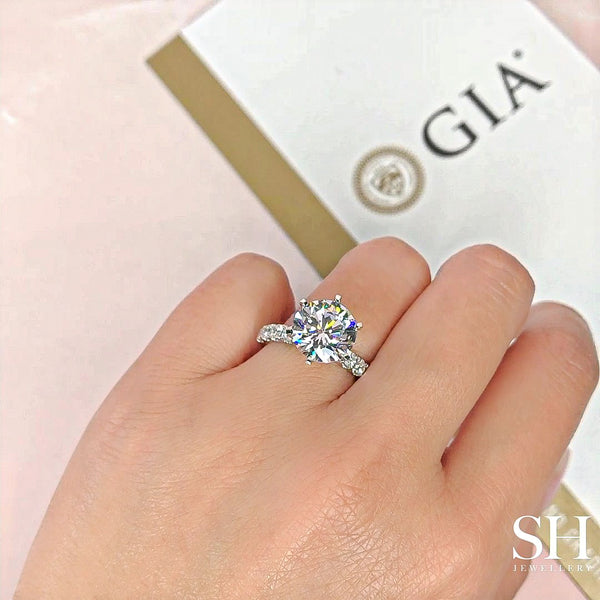The Pros & Cons for Engagement Rings
SHOP NATURAL DIAMOND ENGAGEMENT RINGS
What is a natural diamond?
A natural diamond is a precious gemstone formed around 100 to 200 kilometres below the Earth's surface over millions to billions of years through a geological process involving extreme pressure and high temperatures.
Over time, volcanic activity brings diamond-bearing rock and minerals closer to the Earth's surface, where natural diamonds are then discovered through mining.
Natural diamonds come in a variety of shapes, sizes and colours, influenced by factors such as impurities, pressure and temperature conditions during their formation. They hold immense cultural, emotional and historical value due to their rarity, long geological history, and the allure associated with their natural origin.
What is a lab-grown or synthetic diamond?
A lab-grown diamond, also known as a synthetic diamond, is created in a controlled laboratory environment, rather than formed naturally in the Earth's mantle. Synthetic diamonds have the same physical, chemical and optical properties as natural diamonds, including their hardness, brilliance and ability to refract light, but are man-made by replicating the conditions that lead to diamond formation in nature.
Does SH Jewellery sell natural diamonds or synthetic diamonds?
SH Jewellery sells natural diamonds graded D, E and F on the 4Cs colour scale, representing the top colour range for all colourless diamonds. Our natural diamond GIA reports and matching laser inscriptions verify this independently determined quality and authenticity.
While we specialise in natural diamonds, we also offer lab-grown diamonds instore for couples seeking a more affordable alternative.
What are the benefits of engagement rings with natural diamonds?
Authenticity & Rarity
A natural diamond’s rarity and unique geological origins add to its allure. Owning a natural diamond carries with it a sense of tradition, prestige and connection to the Earth's history.
Emotional Value
Natural diamond engagement rings can come with captivating stories and histories, passed down through generations. The journey of a diamond from mine to market is a tale of discovery, adventure and craftsmanship, contributing to its sentimental value.
Investment Potential
While natural diamonds fluctuate in price, they tend to hold their value over long periods of time, with antique natural diamonds increasing in value by 20% this year.
The intrinsic rarity of natural diamonds, along with their cultural significance, can make them attractive as an investment, particularly with larger, high-quality stones.
Variety & Uniqueness
Natural diamonds exhibit an incredible range of colours, sizes and characteristics, resulting in truly one-of-a-kind gemstones. Each diamond is like a fingerprint of Mother Nature, offering a level of individuality that lab-grown diamonds might find challenging to replicate.
What are the benefits of lab-grown diamonds?
Production Speed
Laboratory-grown diamonds can take as little as a few weeks to several months to grow, depending on the desired size and quality; comparably fast to their natural counterparts. Once grown, SH Jewellery’s lab-made diamonds are cut, polished and graded by the IGI to produce a Laboratory-Grown Diamond Report.
Cost-Effectiveness
Lab-grown diamonds are more affordable than their natural counterparts of similar quality and size. This accessibility means those seeking affordable engagement rings can choose a larger lab-grown diamond for the same price.
Debunking Myths About Laboratory-Grown Diamonds
In April 2023, the Natural Diamond Council released an analytical report, Diamond Facts: Addressing Myths And Misconceptions About The Diamond Industry.
The report addressed common misconceptions about lab-grown diamonds, which the Natural Diamond Council CEO points out in the foreword,
“...erode trust, and, in the long run can be harmful – not only to the diamond industry but especially to those who most depend on the positive impact of diamonds such as the communities who live where diamonds come from.”
Let’s take a look at the top three outdated and factually inaccurate narratives about lab-grown and natural diamonds explored in the report…
MYTH 1. Lab-Grown Diamonds Cannot Be Detected From Natural Diamonds
While it is not possible to tell the difference between a lab-created diamond and a natural diamond with the naked eye alone, all synthetic diamonds can be detected using professional verification instruments.
There are more than 40 instruments available on the market today capable of detecting the difference, which use a variety of technologies to identify the differing growth patterns between natural and lab-grown diamonds.

MYTH 2. Laboratory-Grown Diamonds Are More Sustainable
The manufacturing process for synthetic diamonds may only last a few weeks, but it is energy-intensive, requiring temperatures similar to 20% of that of the Sun’s surface.
When more than 60% of laboratory-grown diamonds are mass-produced in China and India (where 63% and 74% of grid electricity is produced by coal), sweeping claims of synthetic diamonds’ sustainability can be vastly overstated.
A considerable amount of water is also required in some factories to cool reactors, and energy is needed to stabilise factory environments to prevent external conditions impacting synthetic diamonds’ growth.
The energy mix where laboratory-grown diamonds are created is therefore important when determining how sustainable synthetic diamonds really are.
Claims that lab-grown diamonds are entirely mining-free are also misleading, when synthetic diamond production processes require graphite and metals, and the reactors used to grow laboratory-made diamonds are built with metals originating from mining.
Synthetic diamonds produced via CVD (the commonly used name for diamonds grown in a lab using chemical vapour deposition) also require hydrogen and methane; methane is generally sourced from mining gas, oil and coal, as well as oil drilling.
MYTH 3. Natural Diamonds Don’t Benefit the Countries They Come From
Laboratory-grown diamond production relies on technology-based manufacturing. The number of employees needed for direct production is therefore significantly smaller than that of the natural diamond industry.
There is also much less local procurement, infrastructure development and social investments made in local communities during the production of synthetic diamonds. The lab-grown diamond industry therefore does not offer the same socioeconomic benefits for communities as the natural diamond industry, which operates largely in developing countries, where it contributes to the important economic growth of local communities.
Are lab-grown diamonds better than natural diamonds?
Ultimately, the choice between natural diamonds and lab-grown diamonds depends on your personal values, preferences, budget and circumstances. If you are drawn to the traditional allure of Earth-formed gems, natural diamond engagement rings offer a deep-rooted connection to nature and history in the form of an increasingly rare and finite resource.
To view the full range of natural diamond engagement rings and diamond wedding bands at SH Jewellery Melbourne, make a booking with our non-commissioned Diamond Jewellery Consultants, or shop online with free delivery and 30-day exchange.
We look forward to helping you find ‘The One’.














